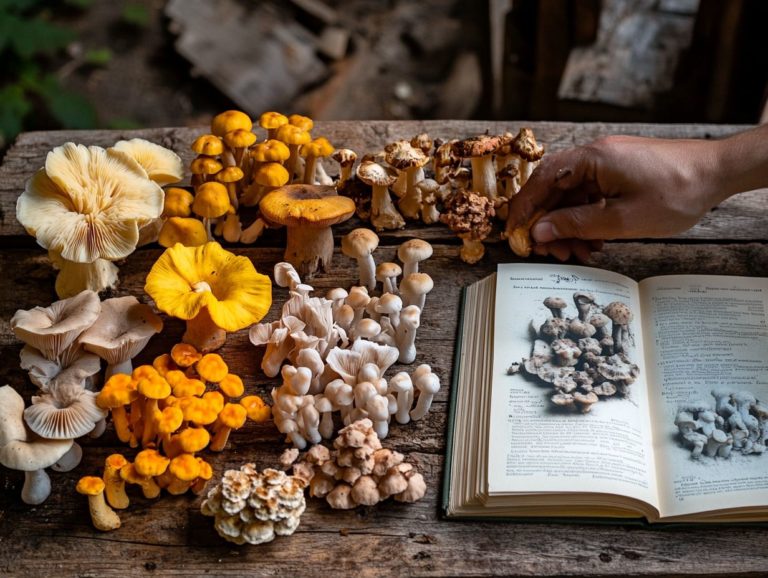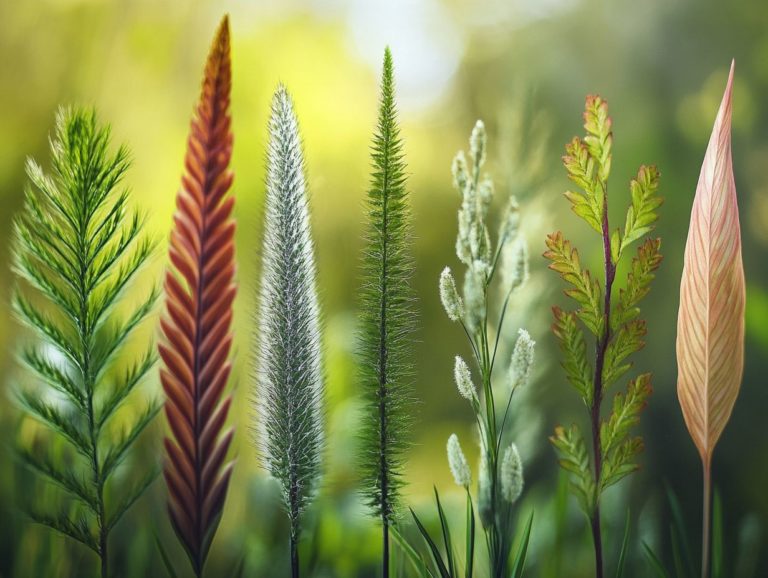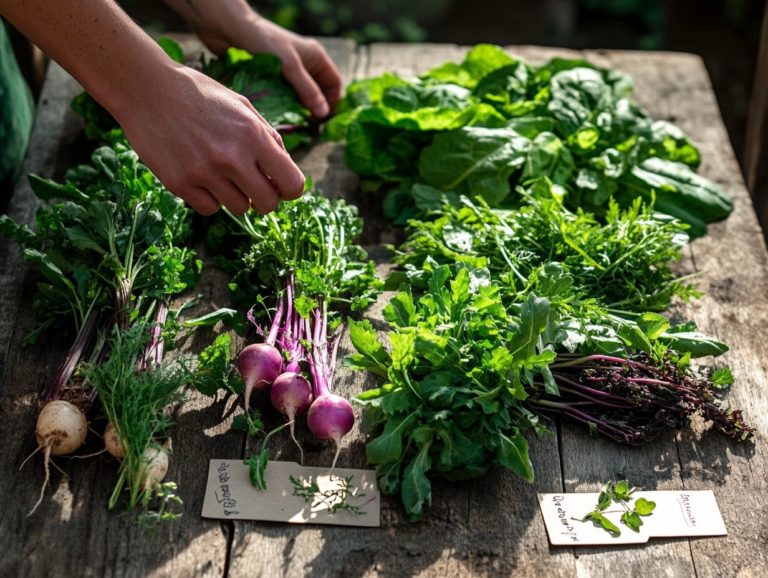Identifying Toxic vs. Edible Mushrooms
Mushrooms are remarkable organisms, presenting a stunning array of flavors and textures. However, not all wild mushrooms are safe for consumption.
This article explores the factors that make certain mushrooms toxic and provides insights on identifying them. You ll discover common toxic varieties and the dangers they pose, along with guidance on recognizing safe, nutritious options.
You ll also find tips on foraging and preparing edible mushrooms, as well as essential information on what to do in the unfortunate event of accidental poisoning.
Join us as we explore the fascinating world of mushrooms!
Contents
- Key Takeaways:
- Common Toxic Mushrooms
- Edible Mushrooms
- How to Safely Forage for Mushrooms
- What to Do if You Accidentally Eat a Toxic Mushroom
- Symptoms and Treatment
- Frequently Asked Questions
- What are some common characteristics of toxic mushrooms, such as Jack-O -Lanterns and Amanita species?
- How can I tell if a mushroom is edible, such as Morels or Furman University‘s cultivated varieties?
- Are all mushrooms with a strong smell toxic, like some Amanita species?
- Can I rely on color alone to determine if a mushroom is toxic or edible, like distinguishing False Morels from their edible counterparts?
- What should I do if I accidentally consume a toxic mushroom, such as a Death Cap?
- Can I rely on online resources for mushroom identification, such as those from the North American Mycological Association?
Key Takeaways:

- Identifying toxic mushrooms is essential because they can be deadly.
- Edible mushrooms provide nutritional benefits, but they must be correctly identified to prevent mixing them up with toxic types.
- To forage safely, research and educate yourself on mushroom identification and always err on the side of caution when unsure.
What are Mushrooms and Why are Some Toxic?
Mushrooms are a captivating and diverse group of fungi found in various habitats across North America. They play crucial roles in ecosystems as organisms that break down dead material and work together with plants. However, tread carefully; some species can be incredibly toxic, posing significant risks for foragers and culinary enthusiasts alike.
These organisms feature a unique structure that includes the underground network that helps mushrooms absorb nutrients and the fruiting bodies those familiar caps and stems that grace the forest floor. By breaking down organic matter, mushrooms contribute to soil fertility, recycle nutrients, and form symbiotic relationships with plants, ultimately enhancing plant growth.
Given their astonishing diversity, proper mushroom identification is vital. You might find yourself in a pickle since some delectable varieties like chanterelles or morels can easily be mistaken for dangerous species, such as the notorious Amanita. Therefore, developing a thorough understanding of mushroom characteristics, morphology, and habitat will enable you to forage responsibly and safely, enriching both your culinary adventures and your appreciation for the natural world.
Common Toxic Mushrooms
Among the vast array of mushrooms, certain species stand out for their toxicity, making understanding edible vs. toxic plants essential for anyone serious about foraging and identification.
The Death Cap, Destroying Angels, and Jack-O -Lanterns are prime examples of poisonous mushrooms that can lead to severe illness or even death if consumed. This reality underscores the crucial need for precise mushroom identification and a keen awareness of the risks involved in foraging.
Identification and Dangers
Accurate mushroom identification is essential for anyone venturing into foraging, as even the most seasoned foragers can mistakenly identify edible mushrooms and encounter the dangers of poisonous varieties. By utilizing mushroom identification keys and following effective foraging tips, you can significantly reduce the risk of consuming toxic mushrooms, ensuring a safe and enjoyable experience in the great outdoors.
Field guides are invaluable resources, offering detailed descriptions and images that help distinguish between similar species. You might also consider using smartphone apps designed for mycology, which can enhance your identification process by providing real-time information and community support.
It’s crucial to remember that even the most reliable tools cannot substitute for careful observation and knowledge. The potential dangers of consuming unidentified mushrooms highlight the importance of attending workshops or joining local foraging groups, where you can learn directly from experienced foragers.
By prioritizing safety and education, you can cultivate a deeper appreciation for the intricate world of mushroom foraging.
Start your mushroom foraging adventure today! Stay safe and have fun!
Edible Mushrooms

Discover a remarkable array of edible mushrooms, such as Chanterelles and Morels, that elevate your culinary adventures while providing valuable nutritional benefits. Mushroom foraging is a rewarding pursuit for both novice and experienced foragers.
Consider popular varieties like Chanterelles, Morels, and Lions Mane; their unique flavors and culinary uses make them highly coveted. This invites you to explore local habitats and engage with nature as you seek out these exquisite fungi.
Identifying Safe and Nutritious Varieties
Identifying safe and nutritious mushroom varieties, including Maitake and Pleurotus ostreatus, is essential for anyone diving into mushroom foraging. The rewards can be both delicious and health-promoting when you choose the right species.
By following established foraging tips and employing simple ways to identify mushrooms, you can uncover a variety of edible mushrooms that enhance your culinary creations and provide essential nutrients.
Using reliable field guides can significantly enhance your foraging experience and help you navigate the intricacies of different species and their habitats. Connecting with local mushroom groups, like the North American Mycological Association, offers invaluable support and opportunities for hands-on learning and sharing insights on seasonal finds.
By closely observing characteristics such as color, texture, and spore prints, you can refine your skills in distinguishing edible varieties from their harmful counterparts. This collaborative approach enriches your foraging journey and deepens your appreciation for the fascinating world of fungi.
How to Safely Forage for Mushrooms
Get ready for an exhilarating outdoor adventure with mushroom hunting! You can uncover delicious, edible mushrooms in places like California and Canada. However, it’s essential to follow safety precautions and foraging tips diligently.
Understanding the right habitats where different mushrooms flourish, along with careful identification skills and knowledge of local species, can elevate your foraging experience and ensure a bountiful harvest.
Tips for Finding and Preparing Edible Mushrooms
Successful mushroom foraging relies on grasping effective tips for finding and preparing edible mushrooms, transforming a simple outdoor excursion into a delightful culinary adventure. Arm yourself with knowledge about seasonal availability, habitat preferences, and culinary uses, including how to prepare mushrooms from Mushroom Mountain, to maximize your harvest and savor exquisite dishes.
Familiarize yourself with local mushroom varieties and their distinguishing features to steer clear of potential hazards. Utilizing field guides and joining local foraging groups can provide invaluable insights into safe species.
After gathering your foraged treasures, cleaning them properly is crucial. A gentle brush or cloth works wonders to remove dirt without damaging their delicate structure.
For preparation, consider saut ing them in olive oil with garlic and herbs to elevate their flavor. You can add your saut ed mushrooms to:
- risottos
- pasta
- as a topping on toasted bread
This creates a quick appetizer that beautifully showcases the earthy essence of your foraged finds.
What to Do if You Accidentally Eat a Toxic Mushroom

Accidentally consuming a toxic mushroom can be a harrowing experience, underscoring the importance of being aware of the symptoms and the appropriate treatment options available to you.
Understanding the potential hazards posed by various toxic mushrooms, such as Death Caps and Jack-O -Lanterns, along with timely actions like seeking medical attention and accurately identifying the species involved, is crucial for your safety and can save your life.
Symptoms and Treatment
Symptoms of mushroom poisoning can vary significantly based on the type of toxic mushroom you’ve ingested. Common signs to watch for include stomach problems, confusion, and, in severe cases, organ failure. Recognizing these symptoms promptly and seeking immediate medical intervention are crucial, especially when dealing with notorious toxic mushrooms like Death Caps, Destroying Angels, and Amanita.
In addition to stomach problems like nausea, vomiting, and diarrhea, you might also experience neurological signs such as seizures or altered mental status. For example, with the Amanita species, symptoms can be delayed, surfacing 6 to 12 hours after consumption, making diagnosis more challenging. At this point, securing medical attention becomes increasingly vital.
Healthcare providers emphasize the importance of identifying the specific mushroom involved, especially in cases involving Jack-O -Lanterns. Accurate identification aids in tailoring treatment protocols. Activated charcoal might be administered to minimize further absorption of toxins, while severe cases could necessitate liver transplants.
Understanding these symptoms and the identification process is essential for supporting medical professionals in managing mushroom poisoning effectively.
Frequently Asked Questions
Before diving into the frequently asked questions, it’s vital to understand the importance of accurate mushroom identification to ensure safety and well-being.
What are some common characteristics of toxic mushrooms, such as Jack-O -Lanterns and Amanita species?
Toxic mushrooms can have a variety of characteristics, but some common ones include bright colors, slimy texture, and a strong odor. They may also have a distinctive ring or cup at the base of the stem.
How can I tell if a mushroom is edible, such as Morels or Furman University‘s cultivated varieties?

Edible mushrooms often have a more muted color, a smooth and firm texture, and a pleasant smell. They may also have gills that are attached to the stem, rather than free and hanging.
Are all mushrooms with a strong smell toxic, like some Amanita species?
No, not all mushrooms with a strong smell are toxic. Some edible mushrooms, such as truffles, have a strong and distinctive aroma. However, it’s always best to err on the side of caution and properly identify a mushroom before consuming it.
Can I rely on color alone to determine if a mushroom is toxic or edible, like distinguishing False Morels from their edible counterparts?
No, color alone is not a reliable indicator of a mushroom’s toxicity. While some toxic mushrooms may have bright or unusual colors, there are also many edible mushrooms with similar appearances. Always use multiple identification methods when foraging for mushrooms.
What should I do if I accidentally consume a toxic mushroom, such as a Death Cap?
If you suspect you have consumed a toxic mushroom, seek immediate medical attention. Do not try to induce vomiting or treat the symptoms on your own. It’s important to know the specific species of mushroom you ingested so that proper treatment can be administered. Memorize the symptoms and always carry a mushroom identification guide for future safety.
Can I rely on online resources for mushroom identification, such as those from the North American Mycological Association?
While there are many reputable online resources for identifying mushrooms, it’s always best to consult with an experienced mycologist or attend a foraging class before consuming any wild mushroom. Some mushrooms can have similar appearances, and it takes a trained eye to differentiate between them.






